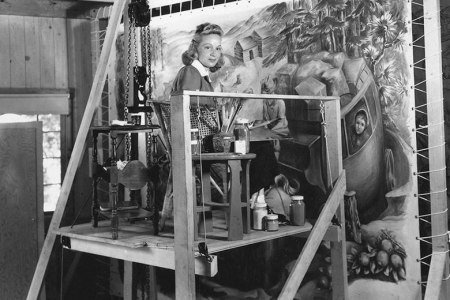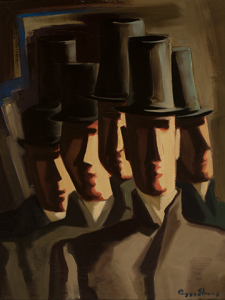
Biography
It is difficult to separate the artwork of Peggy Strong from the tragedy of her life. She was born in Tacoma, WA and raised in a financially comfortable environment. She loved horseback riding and sketching as a child, often combining the two interests in sketches of horses. She attended the Annie Wright School in Tacoma and studied art with Alice Engley Beek. She attended the University of Washington.
Strong was traveling cross-country in 1933, planning to board a ship for Paris, when tragedy struck. A car wreck in Wyoming left the lower half of her body permanently paralyzed. Her mother took her to Detroit for surgery following the accident, where she famously sculpted soap bars while confined to a prone position for weeks. As she recovered from the accident, she studied figure drawing and portraiture with Sarkis Sarkisian, who became a lifelong mentor. She also worked under Frederick Taubes, who taught her how to grind her own pigments, and with Mark Tobey.
Strong's work was first exhibited in 1936 at the Seattle Art Museum's Northwest Annual show. There followed many other local showings of her work. In 1938 her "Woman in Green" was included in the National Exhibition of American Art in New York. She won the Seattle Art Museum's Purchase Prize in 1938 for "Mountain Merry Go Round" and was chosen as part of the Golden Gate International Exhibition at the San Francisco World's Fair in 1939.
In 1940 Strong won a commission for a large mural at the Wenatchee, WA Post Office. Her father used his engineering skills to construct a lift for Peggy's wheelchair so that she could work on the mural in her home studio. Fame from this work led to a solo show at the Seattle Art Museum.
Strong sought to be a very independent individual. She had a car outfitted with hand controls in which she undertook long journeys, some hauling a camping trailer behind the car. She resumed, insofar as it was possible, the active sporting life that she loved. She took up swimming, hoping to strengthen her shoulders and arms and enable her to work through longer sessions in her studio.
Strong moved to San Francisco in 1940. She received portrait commissions there and in New York, where she worked with Portraits, Inc. and was hired by some of their wealthy clients. She completed two war-related murals. One for the Naval Officers Club in Dutch Harbor, AK had a circus theme; the other for the Transit Lounge at Tacoma's Union Station depicted Paul Bunyan. The Bunyan mural now hangs in the Wheelock Student Center dining hall at the University of Puget Sound in Tacoma.
In San Francisco Strong met the Reverend Howard Thurman, a prominent Black theologian and mentor to civil rights leaders, including Martin Luther King, Jr. They got together weekly, discussing matters in theology and philosophy. She gave him painting lessons, and he put on a solo exhibition for her at this church. Strong's health declined with the onset of liver disease, from which she died in 1956. In her last years, her expressionist studio works took on a darkening tone, conveying the increasing despair and hopelessness of her personal situation.


Critical Analysis
There were two sides to Peggy Strong's work. One was the realist, representational side shown in her various murals. The other had an expressionist tone, dramatized by her hand-ground pigments. As mentioned, the challenges of her personal life may have drawn her to darker images in her expressist work as she aged. But a technical excellence shines through all of this work, whether in the carefree tones of her murals or the sombre images of her later easel paintings.
Murals
- Wenatchee, Washington - Wenatchee Valley Museum: The Saga of Wenatchee
- Wenatchee, Washington - Wenatchee Valley Museum: The Saga of Wenatchee (2017 photos)
References
- The Artwork of Peggy Strong, Tacoma History May 7 (2017).
- Gale Fiege, Edmonds museum showcases artist whose life was cut short, Everett Herald September 9 (2016).
- Peggy Strong - Remembered by Her Sister Jean Walkinshaw.
- Peggy Strong Artist of the Early 20th Century, Nana Carrillo Fine Art April 3 (2017).
- Michael Upchurch, Peggy Strong retrospective raises more questions than it answers about her career, Seattle Times October 25 (2016).
- Linda Van Norden, Talent and Ambition Triumph, Kappa Alpha Theta Volume 54, Number 1 (1940).
- Chris Rader, Wenatchee Mural Painter Was Resilient, Wenatchee Valley Museum 05/16/2024 (2024).